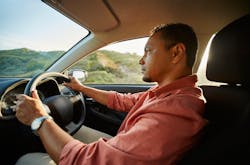By now I am sure you’ve heard about the ambitious move by Uber to pre-empt a drive-time regulatory effort by voluntarily adopting a 12-hours on/six-hours off policy.
Sachin Kansal, director of product management at Uber, announced the move in a blog post, noting that a new feature on its driver’s app will provide “periodic notifications” when a driver approaches the new 12-hour driving time limit. It’ll then automatically take the driver offline for six straight hours when that 12-hour maximum has been reached.
[Those driving limits differ depending on the location, though. For example, New York City mandates a 10-hour “passenger time” limit for taxi and limousine drivers.]
“While nearly 60% of U.S. drivers use Uber less than 10 hours a week, we want to do our part to help prevent drowsy driving,” Kansal said in his blog post. “That’s why we’re taking a step forward by launching a feature across the country that prompts drivers to go offline for six straight hours after a total of 12 hours of driving time. This move will strengthen our approach to help keep riders and drivers safe on the road while preserving the flexibility drivers tell us they love.”
He added that “everyone knows that drinking and driving is dangerous, but many don’t know the risks or warning signs of drowsy driving.” As such, Uber’s “community guidelines” make clear that it’s important to “take a break” when feeling tired on the road, he added.
“We’ve also piloted features like an in-app notification that reminds drivers of this,” Kansal said. “According to the experts, raising awareness is key.”
And the “experts” are liking this move – a lot. “Driver fatigue is a serious and underappreciated traffic safety issue, and states need all the help they can get to address it. GHSA is thrilled that Uber is taking steps to prevent drowsy driving by limiting the hours a driver can be behind the wheel,” noted Jonathan Adkins, executive director of the Governors Highway Safety Association. “This new feature has tremendous potential to protect not only Uber driver-partners, but also their passengers and, ultimately, all road users.”
“The National Sleep Foundation’s validated Sleep Health Index consistently finds that American adults only feel well-rested four days out of the week. Furthermore, the public is not fully aware of how this lack of good, restorative sleep can affect their overall well-being,” added David Cloud, CEO of the National Sleep Foundation. “This not only highlights the importance of outreach and education to help raise public awareness, but also the need for strategies that promote sleep health and safety. We’re pleased to see Uber taking this step and using technology to elevate the importance of this issue.”
Yet, you know what? Uber’s in-app notification protocol suspiciously seems to mimic what an electronic logging device (ELD) is supposed to do in trucking – something that caught the attention of Pete Allen, chief client officer at MiX Telematics.
“When I heard about this on the news, I was taken aback,” he told me by phone. “Fatigue has been proven to lead to crashes and other unsafe driving events. So I thought it very interesting and forward-thinking for them to do this for their entire driver work force.”
While the 12/6 rule is not the same as the 14/10 rule for truckers, Allen believes “the same intent” is there, though he remains curious as to why Uber didn’t synch its drive-time rules with a 24-hour clock.
“I don’t know why it’s different, but it is a good step towards addressing fatigue,” he explained. “What also struck me originally is that they are not being mandated to do this – they are being the ‘early adopter’ here, taking the lead. I’m personally not a big fan of regulation so I’d love to see similar companies adopt this approach. Making the rules yourself leaves you much better off.”
Allen also thinks this new drive-time feature programmed into Uber’s app “opens the door” to other telematics-driven monitoring options, such as collecting data on hard braking incidents to allow for driver coaching as well as for restricting cell phone usage to avoid distracted driving.
“As a passenger, it would be nice if you had data to monitor this, especially so you could create a better and more uniform ride ‘experience’ from a safety perspective,” he added.
We’ll see how far Uber decides to take all this.
About the Author
Sean Kilcarr
Editor in Chief
Sean Kilcarr is a former longtime FleetOwner senior editor who wrote for the publication from 2000 to 2018. He served as editor-in-chief from 2017 to 2018.
